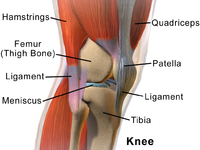
Photo from wikipedia
OBJECTIVE We aim to investigate if we need additional trials on exercise in knee osteoarthritis (OA) to accept a certain effect size to be a 'true' effect size, and new… Click to show full abstract
OBJECTIVE We aim to investigate if we need additional trials on exercise in knee osteoarthritis (OA) to accept a certain effect size to be a 'true' effect size, and new studies are not needed anymore. DESIGN We performed a secondary analyses of a meta-analysis of studies on patients with knee osteoarthritis, on pain immediately post treatment. We performed five different analysis: a) we evaluated publication bias, b) we performed subgroup analysis, c) a sensitivity analysis based on the overall risk of bias (RoB) score, d) a cumulative meta-analysis and e) we developed an extended funnel plot to explore the potential impact of a new study on the summary effect estimate. RESULTS We included 42 studies with in total 6863 patients. The analyses showed that a) there is no clear publication bias, b) subgrouping did not affect the overall effect estimate, c) the effect estimate of exercise is more consistent (no heterogeneity) in the studies of low RoB, d) the benefit of exercise was clear since 2010 and e) the extended funnel plot suggests that an additional study has a none or very limited impact to change the current effect estimate. CONCLUSION Exercise is effective and clinically worthwhile in reducing pain immediately post treatment compared to no or minimal interventions in patients with knee OA and adding new data will unlikely change this conclusion.
Journal Title: Osteoarthritis and cartilage
Year Published: 2019
Link to full text (if available)
Share on Social Media: Sign Up to like & get
recommendations!